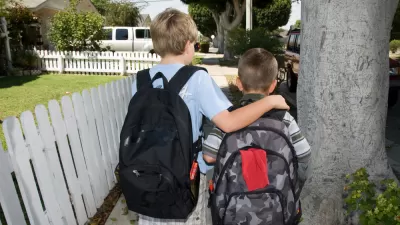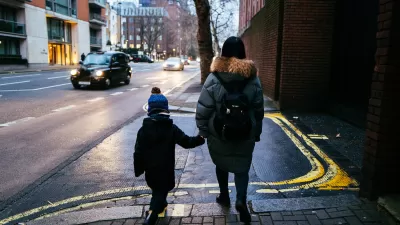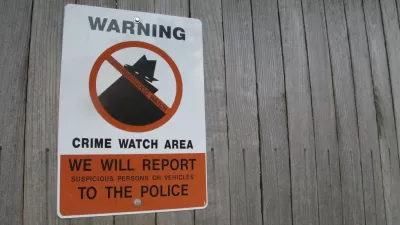Many Americans believe children should not be free to walk alone, because of crime and traffic. But children constantly driven around by their parents or locked away at home are also subject to significant risks.

In 1969, American children walked to school as often as not. But today, many parents frown on children doing anything outside while alone. In fact, some parents have been arrested for allowing their children to walk or play outside.
Why can’t children be free to walk? Many Americans believed that the United States is chock full of perverts ready to grab the nearest unsuspecting child, behave in some indecent manner, and bury them in some deserted place.
In fact, such incidents are rare and possibly becoming even less common over time. According to the FBI, less than 150 American children per year are abducted by strangers, and only 1 percent of abductions of children involve sexual offenders. Where children are victimized, they are usually victimized not by strangers on the street but by acquaintances and relatives in their homes; only 4 percent of all sexual assaults of persons under 12 involved strangers, and 84 percent of them occurred in the victim’s home. Violence against children occurs less frequently than 20 years ago; murders of children under 14 from all causes have declined by about a third since 1993, from 2.2 per 100,000 to 1.5.
Of course, these statistics are unlikely to persuade Americans traumatized by intense television coverage of the most unusual, horrifying crimes. The average American might argue that even if one child is murdered by a stranger every hundred years, children should be kept safely locked away to prevent such horrors.
But this argument proves too much. Why? Because parents who do follow the conventional wisdom are also exposing their children to equally severe risks.
The most long-run risk of state-mandated helicopter parenting is physical harm from lack of exercise. As terrified adults have shoved children off their feet and bikes, childhood obesity has increased, doubling over the past thirty years. In turn, obesity is a risk factor for diabetes, heart disease, cancer and a wide variety of other fatal disease.
Admittedly, cancer and diabetes are long-term health effects; parents can always rationalize the status quo by deciding that children can always get thinner when they grow up, or avoid health problems by eating more nutritiously.
But being driven to school by one’s parents also involves short-term risks: in 2011, about two children per day are killed (and over 300 injured) while they were passengers in cars, more than the number of children murdered by anyone (let alone child-stealing strangers).
In fact, even criminal violence may be as much of a threat to the child constantly with parents as it is to the child walking home from school. Imagine the following situation: criminal X breaks into Mom’s house or decides that he wants to steal Mom’s car, and decides that his life as a criminal would be a lot easier without Mom calling the police or otherwise making trouble. So he shoots Mom dead. If Junior is around, he might not have any scruples about shooting Junior as well. By contrast, X is probably not going to be interested in attacking Junior alone, because Junior has little worth stealing. Thus, being chauffered around by Mom is not risk-free for Junior.
How often does this scenario happen? I don’t know. According to FBI statistics, 744 Americans were murdered in the course of robberies or burglaries, 30 times the number killed in the course of sex crimes. In addition, 4582 murders occurred in unknown circumstances (presumably because the offenders were never caught)—some of which presumably involve such crimes. But I couldn’t find a breakdown of these victims by age.
In sum, a child free to walk to school is subject to some risk of criminal violence (and at even more risk of being run over by fast-moving drivers). But a child who is constantly driven around by her parents is subject to the risks of ill health from inactivity, PLUS the risks of car crashes and criminal violence.
Which risks are greater? I don’t have any idea, and don’t know if there’s any feasible way to calculate these risks. But it seems to me that given this uncertainty, parents should be given the discretion to decide when to err on the side of supervision and when to give their children a little independence.

Planetizen Federal Action Tracker
A weekly monitor of how Trump’s orders and actions are impacting planners and planning in America.

Congressman Proposes Bill to Rename DC Metro “Trump Train”
The Make Autorail Great Again Act would withhold federal funding to the system until the Washington Metropolitan Area Transit Authority (WMATA), rebrands as the Washington Metropolitan Authority for Greater Access (WMAGA).

The Simple Legislative Tool Transforming Vacant Downtowns
In California, Michigan and Georgia, an easy win is bringing dollars — and delight — back to city centers.

The States Losing Rural Delivery Rooms at an Alarming Pace
In some states, as few as 9% of rural hospitals still deliver babies. As a result, rising pre-term births, no adequate pre-term care and "harrowing" close calls are a growing reality.

The Small South Asian Republic Going all in on EVs
Thanks to one simple policy change less than five years ago, 65% of new cars in this Himalayan country are now electric.

DC Backpedals on Bike Lane Protection, Swaps Barriers for Paint
Citing aesthetic concerns, the city is removing the concrete barriers and flexposts that once separated Arizona Avenue cyclists from motor vehicles.
Urban Design for Planners 1: Software Tools
This six-course series explores essential urban design concepts using open source software and equips planners with the tools they need to participate fully in the urban design process.
Planning for Universal Design
Learn the tools for implementing Universal Design in planning regulations.
Smith Gee Studio
City of Charlotte
City of Camden Redevelopment Agency
City of Astoria
Transportation Research & Education Center (TREC) at Portland State University
US High Speed Rail Association
City of Camden Redevelopment Agency
Municipality of Princeton (NJ)






























